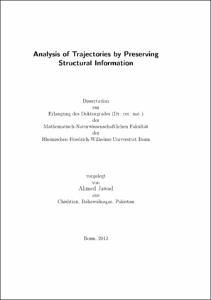Analysis of Trajectories by Preserving Structural Information

Analysis of Trajectories by Preserving Structural Information

| dc.contributor.advisor | Wrobel, Stefan | |
| dc.contributor.author | Jawad, Ahmed | |
| dc.date.accessioned | 2020-04-17T23:46:29Z | |
| dc.date.available | 2020-04-17T23:46:29Z | |
| dc.date.issued | 18.07.2012 | |
| dc.identifier.uri | https://hdl.handle.net/20.500.11811/5345 | |
| dc.description.abstract | The analysis of trajectories from traffic data is an established and yet fast growing area of research in the related fields of Geo-analytics and Geographic Information Systems (GIS). It has a broad range of applications that impact lives of millions of people, e.g., in urban planning, transportation and navigation systems and localized search methods. Most of these applications share some underlying basic tasks which are related to matching, clustering and classification of trajectories. And, these tasks in turn share some underlying problems, i.e., dealing with the noisy and variable length spatio-temporal sequences in the wild. In our view, these problems can be handled in a better manner by exploiting the spatio-temporal relationships (or structural information) in sampled trajectory points that remain considerably unharmed during the measurement process. Although, the usage of such structural information has allowed breakthroughs in other fields related to the analysis of complex data sets [18], surprisingly, there is no existing approach in trajectory analysis that looks at this structural information in a unified way across multiple tasks. In this thesis, we build upon these observations and give a unified treatment of structural information in order to improve trajectory analysis tasks. This treatment explores for the first time that sequences, graphs, and kernels are common to machine learning and geo-analytics. This common language allows to pool the corresponding methods and knowledge to help solving the challenges raised by the ever growing amount of movement data by developing new analysis models and methods. This is illustrated in several ways. For example, we introduce new problem settings, distance functions and a visualization scheme in the area of trajectory analysis. We also connect the broad fild of kernel methods to the analysis of trajectories, and, we strengthen and revisit the link between biological sequence methods and analysis of trajectories. Finally, the results of our experiments show that - by incorporating the structural information - our methods improve over state-of-the-art in the focused tasks, i.e., map matching, clustering and traffic event detection. | |
| dc.language.iso | eng | |
| dc.rights | In Copyright | |
| dc.rights.uri | http://rightsstatements.org/vocab/InC/1.0/ | |
| dc.subject | Geographic Information Systems | |
| dc.subject | Machine Learning | |
| dc.subject.ddc | 004 Informatik | |
| dc.title | Analysis of Trajectories by Preserving Structural Information | |
| dc.type | Dissertation oder Habilitation | |
| dc.publisher.name | Universitäts- und Landesbibliothek Bonn | |
| dc.publisher.location | Bonn | |
| dc.rights.accessRights | openAccess | |
| dc.identifier.urn | https://nbn-resolving.org/urn:nbn:de:hbz:5n-29222 | |
| ulbbn.pubtype | Erstveröffentlichung | |
| ulbbnediss.affiliation.name | Rheinische Friedrich-Wilhelms-Universität Bonn | |
| ulbbnediss.affiliation.location | Bonn | |
| ulbbnediss.thesis.level | Dissertation | |
| ulbbnediss.dissID | 2922 | |
| ulbbnediss.date.accepted | 10.07.2012 | |
| ulbbnediss.fakultaet | Mathematisch-Naturwissenschaftliche Fakultät | |
| dc.contributor.coReferee | Bauckhage, Christian |
Files in this item
This item appears in the following Collection(s)
-
E-Dissertationen (4071)




